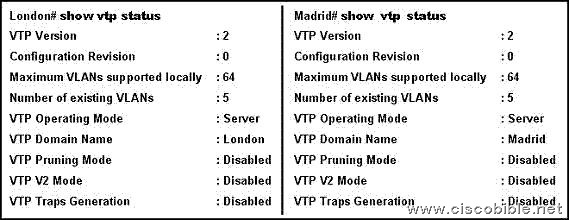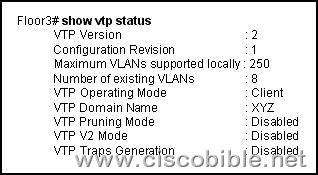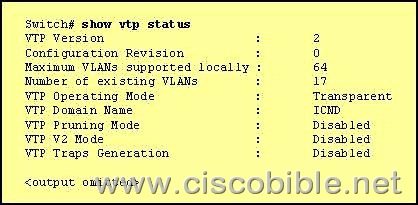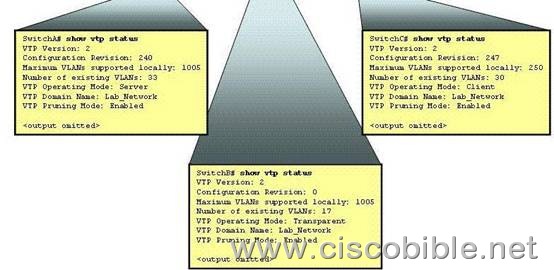1. What is the purpose of the command shown below?
vtp password Fl0r1da
A: It is used to validate the sources of VTP advertisements sent between switches.
B: It is used to access the VTP server to make changes to the VTP configuration.
C: It allows two VTP servers to exist in the same domain, each configured with different passwords.
D: It is the password required when promoting a switch from VTP client mode to VTP server mode.
E: It is used to prevent a switch newly added to the network from sending incorrect VLAN information to the other switches in the domain.
Correct Answers: A
Explanation:
When you create the VTP domain, you have a bunch of options, including setting the domain name, password, operating mode, and pruning capabilities of the switch. Use the vtp global configuration mode command to set all this information.
The purpose of setting password on VTP is to validate the sources of VTP advertisements sent between switches belonging to same VTP domain.
2. A network administrator has configured two switches, named London and Madrid, to use VTP. However, the switches are not sharing VTP messages. Given the command output shown in the graphic, why are these switches not sharing VTP messages?
A: The VTP version is not correctly configured.
B: The VTP operating mode is not correctly configured.
C: The VTP domain name is not correctly configured.
D: VTP pruning mode is disabled.
E: VTP V2 mode is disabled.
F: VTP traps generation is disabled.
Correct Answers: C
Explanation:
When you create the VTP domain, you have a bunch of options, including setting the domain name, password, operating mode, and pruning capabilities of the switch. Use the vtp global configuration mode command to set all this information.
To share the VTP messages switches should have same domain name and password. Mode can be either Server, Transparent, Client.
In the Exhibit one switch has London and another has Madrid domain name, so to exchange VTP message both should have same domain name.
3. Refer to the exhibit. Given the output of the Floor3 switch, what statement describes the operation of this switch?
A: VTP is disabled on this switch.
B: The switch can create, change, and delete VLANs.
C: The switch learns VLAN information but does not save it to NVRAM.
D: The switch can create VLANs locally but will not forward this information to other switches.
E: The switch learns VLAN information and updates the local VLAN data base in NVRAM.
Correct Answers: C
Explanation:
This switch is operated on client VTP mode.
In client mode, switches receive information from VTP servers, but they also send and receive updates, so in this way, they behave like VTP servers. The difference is that they can’t create, change, or delete VLANs. Plus, none of the ports on a client switch can be added to a new VLAN before the VTP server notifies the client switch of the new VLAN.
Also good to know is that VLAN information sent from a VTP server isn’t stored in NVRAM, which is important because it means that if the switch is reset or reloaded, the VLAN information will be deleted. Here’s a hint: If you want a switch to become a server, first make it a client so it receives all the correct VLAN information, then change it to a server.
4. Refer to the exhibit. The show vtp status command is executed at a switch that is generating the exhibited output. Which statement is true for this switch?
A: The switch forwards its VLAN database to other switches in the ICND VTP domain.
B: The configuration revision number increments each time the VLAN database is updated.
C: The switch forwards VTP updates that are sent by other switches in the ICND domain.
D: The VLAN database is updated when VTP information is received from other switches.
Correct Answers: C
Explanation:
Switches in transparent mode don’t participate in the VTP domain or share its VLAN database, but they’ll still forward VTP advertisements through any configured trunk links.
5. What are two results of entering the Switch(config)# vtp mode client command on a Catalyst switch? (Choose two.)
A:The switch will ignore VTP summary advertisements.
B:The switch will forward VTP summary advertisements.
C:The switch will process VTP summary advertisements.
D:The switch will originate VTP summary advertisements.
E:The switch will create, modify and delete VLANs for the entire VTP domain.
Correct Answers: B, C
Explanation :
Server Mode -VTP servers have full control over VLAN creation and modification for their domains. All VTP information is advertised to other switches in the domain, while all received VTP information is synchronized with the other switches. By default, a switch is in VTP server mode. Note that each VTP domain must have at least one server so that VLANs can be created, modified, or deleted, and VLAN information can be propagated.
Client Mode -VTP clients do not allow the administrator to create, change, or delete any VLANs. Instead, they listen to VTP advertisements from other switches and modify their VLAN configurations accordingly. In effect, this is a passive listening mode. Received VTP information is forwarded out trunk links to neighboring switches in the domain, so the switch also acts as a VTP relay.
Transparent Mode -VTP transparent switches do not participate in VTP. While in transparent mode, a switch does not advertise its own VLAN configuration, and a switch does not synchronize its VLAN database with received advertisements. In VTP version 1, a transparent-mode switch does not even relay VTP information it receives to other switches, unless its VTP domain names and VTP version numbers match those of the other switches. In VTP version 2, transparent switches do forward received VTP advertisements out of their trunk ports, acting as VTP relays. This occurs regardless of the VTP domain name setting.
6. Refer to the exhibit. The network administrator has discovered that the VLAN configuration of SwitchC is not synchronized with the rest of the switched network. Why is SwitchC not receiving VTP updates?
A: SwitchB is not relaying VTP advertisements to SwitchC.
B: SwitchC has fewer existing VLANs than does SwitchA.
C: SwitchA supports a greater number of VLANs than does SwitchC.
D: SwitchC has a revision number higher than that being advertised.
E: SwitchC should be operating in VTP server mode to receive VTP updates.
F: SwitchB should be operating in VTP server or client mode to relay VTP updates.
Correct Answers: D
Explanation:
The configuration revision number is a 32-bit number that indicates the level of revision for a VTP packet. Each VTP device tracks the VTP configuration revision number that is assigned to it. Most of the VTP packets contain the VTP configuration revision number of the sender.
This information is used in order to determine whether the received information is more recent than the current version. Each time that you make a VLAN change in a VTP device, the configuration revision is incremented by one. In this case, SwitchC is configured as a client but the revision number is higher than the other switches, so it will ignore the updates. In order to reset the configuration revision of a switch, change the VTP domain name, and then change the name back to the original name.









Good Overview